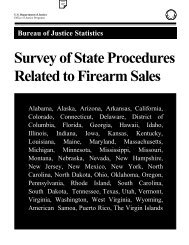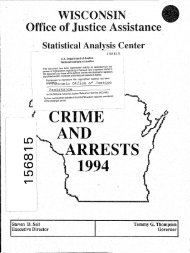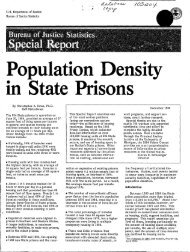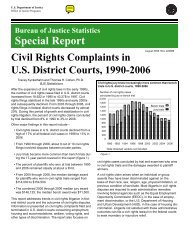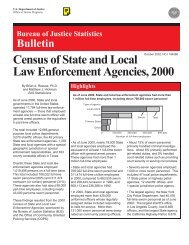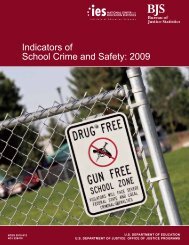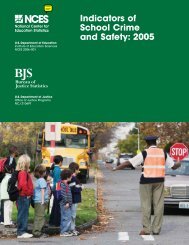Sourcebook of Criminal Justice Statistics, 1983 - Bureau of Justice ...
Sourcebook of Criminal Justice Statistics, 1983 - Bureau of Justice ...
Sourcebook of Criminal Justice Statistics, 1983 - Bureau of Justice ...
Create successful ePaper yourself
Turn your PDF publications into a flip-book with our unique Google optimized e-Paper software.
--------------------<strong>Sourcebook</strong> <strong>of</strong> <strong>Criminal</strong> <strong>Justice</strong> <strong>Statistics</strong> <strong>1983</strong>Table 1.49 Number and percent <strong>of</strong> delinquency prevention programs providing variousservices, by type <strong>of</strong> service, United States, 1979 and 1981--ContinuedService categoryDelinguenc:l (;!reventlan erogrQ!m1979 survW198 I sur'6ey(N=489)(N=248)Number <strong>of</strong> Percent <strong>of</strong> NJmber <strong>of</strong> Percent <strong>of</strong>programs programs programs progroms<strong>of</strong>ferlnq, <strong>of</strong>fering <strong>of</strong>fer.ln% <strong>of</strong>fe~in%service service service serviceStudent Involvement in decisionsaffecting self (Includes participationin selectlngcurriculum, InvolvementsIn discipline and grievance procedures,mastery learning) 17 3.5 17 6.8Low student/teacher ratio (under 21:1) 20 4.1 12 4.8Adult working with pre-existing naturalyouth peer groups (inclUdes detachedgang workers and street workers) 21 4.3 9 3.6Neighborhood organization for selfdetermination, Improvement/development 18 3.7 II 4.4Special services for minorities (e.g.,bilingual counselors, native culturestudy groups) 12 2.4 16 6.4Volunteer Job, unpaid work experience(no school credit) 19 3.9 9 3.6Private business/foundation involvementin delivery <strong>of</strong> services (not funding) 16 3.3 8 3.2Alternative education: supplementary,in traditional schO>lI 15 3.1 9 3.6Child obuse and neglect services outside<strong>of</strong> the school, including family violenceservices 6 1.2 17 6.8Target hardening (e.g., vandalism watch,security precautions, block watch,neighborhood patrols, operation 10) 14 2.9 6 2.4Reuniting families 20 4.1 N!>. N!>.Police school liaison 13 2.6 6 2.4Expasure to consequences <strong>of</strong> crime(e.g., jail visits, police lectures,lifer's progro:ns) 8 1.6 8 3.2In-school discipline program (e.g.,in-school suspension) as on alternativeto regular suspension or involvement<strong>of</strong> the juvenile authorities 9 1,8 2 0.8Performance bosed grading (selfas baseline) 9 1.8 0.4Home/school liaison (home-based rewardp~ograms, child development specialist,school-based child abuse and neglectteams) NO. N!>. 2 0.8aMisslng data on services for II programs; 5 from the 1979 survey and 6 from the 1981surve:{;Total exceeds N and percent total exceeds 100.0 because programs typically <strong>of</strong>fermore than one service.Source: Table provided to SOURCEBOOK staff by the Natll.nal Center for theAssessment <strong>of</strong> Delinquent Behavior and Its Prevention, Center for Low and <strong>Justice</strong>,U1iversity <strong>of</strong> Washington, Seattle, Washington. Table adapted by SD.-RCEBOO< staff.1261[I.,1i'\1III1\IiI!IIIiIfIiII)1IIIidljIiIIIIIII11rIIIIIIII1IIiL'Characteristics <strong>of</strong> the <strong>Criminal</strong> <strong>Justice</strong> SystemsAgure 1.9 Dote <strong>of</strong> jail construction, by decade, United States, 1800-1979I'OTE: The data below are from a survey <strong>of</strong> sheriffs conducted between September 1981 and April1982. Questionnaires were mailed to all 3,042 sheriffs listed In the National Sheriffs' Associationdirectory, to other Identifiable county institutions operated as county departments <strong>of</strong> corrections,to city sheriffs, and to larger city jails. The 2,664 completed and returned questionnaires areestimated to represent a response rate In excess <strong>of</strong> 80 percent, Size <strong>of</strong> jail was reported by2,452 <strong>of</strong> the respondents. Therefore, the size <strong>of</strong> jail subcategories do not sum to 2,664, the totalfor all Jails.A jail was defined by the Source as "a place where a person is confined after arrest toremain there in a pre-trial status unless he is bonded out or released on his own recognizance,etc.; after his adjudication by the courts, he can be returned to this some facility to serve asentence" (Source, p. 10).Percents do not add to 100 due to multiple responses. Data have been revised fromoriginal presentation through information provided ,by the Source.Not included in this figure are 108 jails constructed during the ! 980's and 291 jails that didnot complete this portion <strong>of</strong> the survey. The percents were computed on the basis <strong>of</strong> 2,265 jailsthat responded to this survey item and that indicated that jail construction occurred between1800 and 1979.1800 to 1809 (N =7)1810 to 1819 (N =2)1820 to 1829 (N =4)1830 to 1839 (N = 8)1840 to 1849 (N =4)1850 to 1859 (N =20)1860 to 1869 (N = 19)c:0 '-n 1870 to 1879 (N =5e)2iii~c:0 1880 to 1889 (N = 56)u'0Q) 1890 to 1899(N = 86)"0IIIUQ)1900 to 1909019iO to 1919(N=2,265)Percent <strong>of</strong> jails0 10 20 30I I I,'I(N =87)"\(N=110)1920 to 1929 J (N = 151)1930 to 1939 J (N = 264)1940 to 1949 (N = 85)1950 to 1959 I (N = 276)1960 to 1969 I (N = 390)1970 to 1979/JJ(N = 640)Source: Kenneth E. Kerle and Francis R. Ford, The S\tate <strong>of</strong> Our Nation's Jails 1982(Washington, D.C.: National Sheriffs' Association, 1982), p. 79. Figure constructed bysa..RCEBOO< staff. Reprinted by permission.




